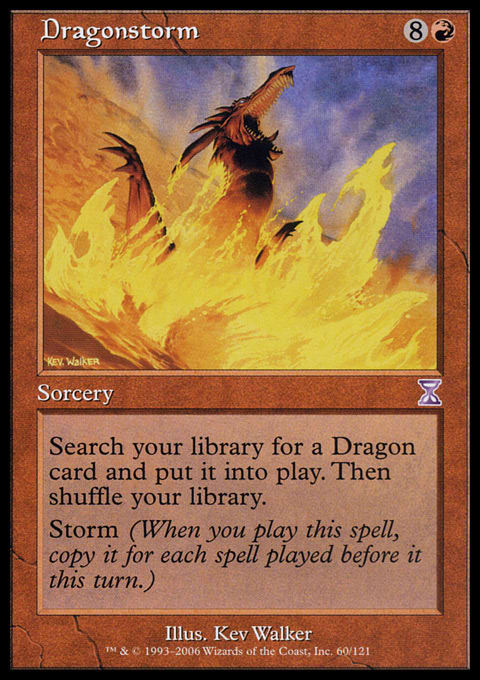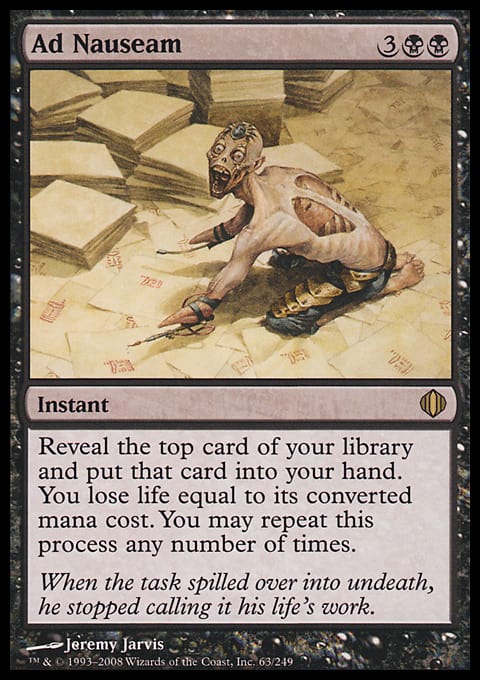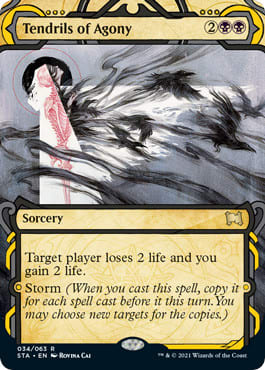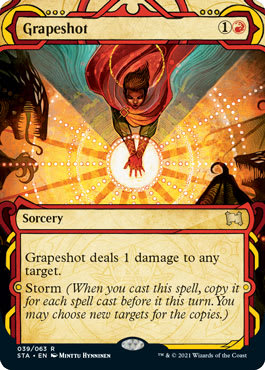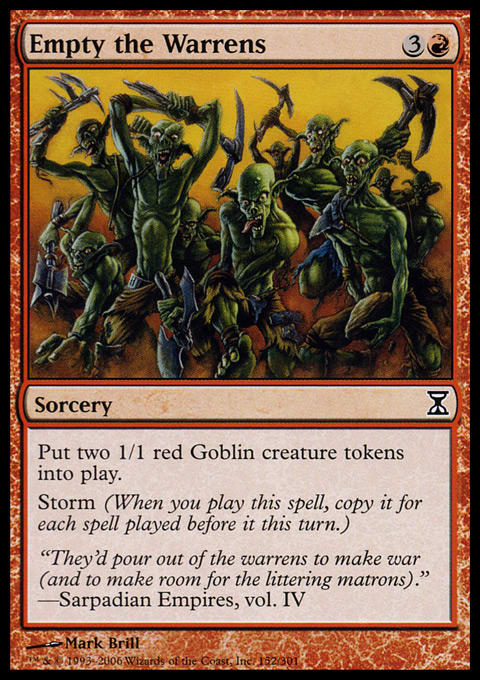I recently wrote about the Dredge keyword mechanic, and its placement on the Storm Scale. As a reminder, the Storm Scale is a ranking of the likelihood that a given mechanic will be reprinted in any future Standard legal set. Dredge is a very powerful and difficult-to-disrupt mechanic, prone to repetitive gameplay. These characteristics earn Dredge a nine out of ten on the Storm Scale, meaning it would take a minor miracle to see printing in a Standard legal set again.
If Dredge is a nine, then what earns a ten? Many antiquated mechanics show up on the list, including Cumulative Upkeep, -0/-1 counters, Banding, Bands with Others, and Ante. Artifact Lands also show up on the list for their busted nature.
Despite being tens, only one mechanic has been deemed by Mark Rosewater as "probably the most broken mechanic we've ever created and it's caused problems every time we brought it back." This keyword is so broken that it led to the creation and naming of the Storm Scale. I am, of course, talking about Storm itself!
What Is Storm?
If you're a fan of eternal play, including Vintage, Legacy, and Modern, then you've likely seen Storm in action before. Newer players, or players who focus on primarily casual play, may not have played much with Storm cards before. To define the mechanic, let's take a look at one of the first Storm card to be printed, all the way back in Scourge.
This card has two bits of rules text. The first part is the card's effect on the game - in the case of Dragonstorm, when you resolve the sorcery, you can search your library for a Dragon card and put it directly into play. Given how huge and powerful Dragons have become in Magic, this is certainly a worthwhile effect. Nine mana is a steep cost, though. Despite being able to tutor up any Dragon you want, it's not easy to justify that casting cost.
Then there's the second part of the card's rules text, boiled down to one word (with a bunch of reminder text): Storm. This simple keyword means that when you play this spell, you copy it for each spell played before it this turn. That includes spells you played and spells your opponents played. Anyone who played spells this turn contributed to your Storm count. Therefore, if you cast a couple Rite of Flames and Seething Songs that turn to ramp to nine mana, you'll get to search your library for Dragon cards again for each of those spells you cast earlier that turn.
Here are a couple more important rules details associated with Storm:
- Storm is a triggered ability that uses the stack. They aren't cast, so they don't cause Storm triggers themselves.
- Copying a spell with Storm doesn't give you another Storm trigger.
- You can counter a spell with Storm or one of the copies, but that doesn't stop the Storm trigger. Without something like Mindbreak Trap, you can use a standard Counterspell to counter just one copy of the spell (not very effective).
In my Dragonstorm example, you may argue that such power is not free - you need to draw the right combination of cards and do a good bit of work in order to maximize an effect like this. You wouldn't be wrong. The problem comes into play with some of the cheaper Storm spells, especially when combined with the right setup cards...
Storm in Constructed Play
When I first started playing Legacy well over a decade ago, my interest in the format can be attributed to the printing of one new card: Ad Nauseam from Shards of Alara.
As soon as I read that card, I wanted to break it. I knew a deck could be built with a low enough average mana value that I'd be able to draw almost my entire deck after resolving this spell. I purchased playsets of cheap mana accelerants, including Mox Diamond, Lotus Petal, Chrome Mox, Lion's Eye Diamond, and Dark Ritual. I researched what other Storm players were using in their decks, and I discovered the power of one mana cantrips, including Brainstorm and Ponder. The deck was nearly complete.
It just needed one more thing: a win condition. Drawing my entire deck would be fun, and I could generate a bunch of mana and draw many cards after resolving Ad Nauseam, but to what end? It didn't take long in my research to find the most common win condition: Tendrils of Agony, a simple "drain 2" sorcery with Storm.
Unlike Dragonstorm, Tendrils of Agony's converted mana cost was just four, making it much easier to resolve. Also, being a Black spell meant one could harness the power of Dark Ritual and Cabal Ritual, two potent mana accelerants. My Legacy deck was ready, and I piloted it to many victories at my local game shop before important parts of the deck became banned (Mystical Tutor was a big one). Despite this, ANT (Ad Nauseam Tendrils) remains a potent one-two punch in Legacy.
Vintage decks also seek to abuse the power of Storm, but they don't bother with the card-drawing engine that is Ad Nauseam. Instead, Beseech the Mirror, Necropotence, and Yawgmoth's Will are engines of choice when building up enough Storm count to cast a lethal Tendrils of Agony.
Storm is also a powerful deck choice in Modern. Tendrils of Agony isn't legal in Modern, however, so players have found a satisfactory alternative: Grapeshot.
Originally printed in Time Spiral, Grapeshot is a Modern-legal card that can also stack up a ton of damage assuming enough spells were cast in the same turn. What do players use to enable a twenty-point Grapeshot turn? The answer is a ton of cantrips like Consider and Preordain, various mana-accelerating rituals, Manamorphose, and one of the most potent sorceries to be printed, Past in Flames. These decks also run a handful of creatures that reduce the casting cost of instants and sorceries by a mana, making it easier to keep the engine moving.
Other Noteworthy Storm Cards
Tendrils of Agony and Grapeshot may be popular Storm win conditions in Constructed play, but there are a couple other noteworthy cards featuring the Storm keyword. Here are a handful:
- Brainfreeze: The milling engine combines very well with Underworld Breach, making for a potent combo in Vintage Cube particularly. In 60-card Constructed play, Tendrils of Agony is more efficient (10 copies of Tendrils of Agony is lethal, whereas you'll typically need 15 or 16 copies of Brainfreeze to deck someone).
- Empty the Warrens: Sometimes it's difficult to reliably generate enough storm count to win with a single Tendrils of Agony. Empty the Warrens is a popular alternative because usually four or five copies is enough to apply a great deal of pressure on your opponent.
- Flusterstorm: A powerful counterspell with Storm that effectively fights other Storm decks. This is another way of disrupting the deck after a Storm trigger is placed on the stack.
- Mind's Desire: An entire Extended deck was built around this card once upon a time (TEPS, or "The Extended Perfect Storm.") At one point this card was so powerful, it was banned in Legacy. It has since fallen out of favor, but remains restricted in Vintage for its inherent power level.
- Bitter Ordeal: A Future Sight card that introduced the concept of Gravestorm, an interesting riff on Storm where the trigger counts the number of permanents that entered a graveyard this turn rather than spells cast. The keyword was reused on Follow the Bodies, a spell from the Murders at Karlov Manor Commander set.
- Friarball: A brand new Mystery Booster 2 test card that features another spin on Storm. Dubbed "Coststorm," Friarball is copied for each different mana value among other spells and lands you've played that turn. It seems complicated to track, so I don't know if it'll ever see tournament-legal play. It does strike me as a somewhat "fixed" iteration of the Storm mechanic.
Wrapping It Up
If given the chance, I wonder if Mark Rosewater would go back in time to eradicate Storm. The mechanic has led to a thriving archetype in Constructed play, but at a cost. The mechanic is so powerful that Mark Rosewater would consider it a major miracle to see a reappearance in Standard. The ability is simply too powerful when combined with rituals, fast mana, accelerants, and engines like Past in Flames, Underworld Breach, and Ad Nauseam.
Despite its oppressive power, I think Storm has been a net positive for Magic. The mechanic leads to a form of gameplay that some players (including myself) have grown to enjoy. A Storm deck is almost like a puzzle that needs to be solved, requiring the right spells at the right moments. Even before Ad Nauseam Tendrils was a Legacy deck, I found myself brewing casually with zero mana creatures and Temporal Fissure. I knew there was power to be unlocked with Storm, even if I couldn't come up with the solution without ultimately net decking.
Just because we won't see Storm in Standard again doesn't mean Wizards won't continue to innovate in this space. We'll see the mechanic show up in reprint sets, and possibly some future Commander sets as well. Just don't expect to see new cards that can straight-up win games with a high enough Storm count. I'm sure Wizards of the Coast is wary of warping eternal formats even further by printing the wrong, overpowered Storm card. Hopefully Tendrils of Agony, Grapeshot, and Mind's Desire were the worst of them, but you never know!














